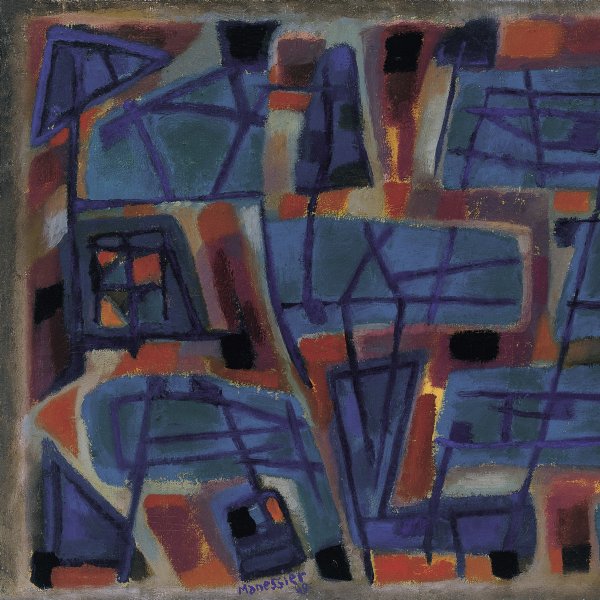Alfred Manessier
Saint-Ouen, 1911-Orleans, 1993
Since 1945, Alfred Manessier has been acknowledged as one of the most important figures of his generation. He was born on 5 December 1911 in the north of France, in the region of Picardie, in the village of Saint-Ouen, between Abbeville and Amiens-the towns in which he spent his childhood and youth. He began to paint from nature at the age of twelve in the Bay of the Somme, which remained a source of inspiration for the rest of his life.
From 1931 to 1935 he studied architecture at the Ecole Nationale des Beaux-Arts in Paris, to comply with his father's wishes; but his passion for painting often attracted him to the Louvre where he copied Rembrandt, Tintoretto, Rubens, Renoir. In the evening he attended some free academies in Montparnasse, and later the Académie Ranson (where he was briefly introduced to the technique of fresco painting, a course recently opened by Bissière). The works from his youth were influenced by Cubism, and later by Surrealism.
A long military service, his father's death in 1936, and the outbreak of the war (with his consequent mobilisation) forced him to abandon his art, which he took up again in Paris in 1942, a year after the exhibition Vingt jeunes Peintres de Tradition Française, to which he had contributed with three Surrealist paintings, including The Last Horse dating from 1938, conceived as a manifesto against Hitler. Together with Bazaine, Lapicque and the artists Manessier created a new movement of living art during the Occupation. Fame came for him after the Liberation: First Prize at the Biennial Art competition in Sâo Paulo in 1952; First Prize at the Carnegie Institute in Pittsburgh in 1955; First Prize for painting and the Prize of the Catholic Liturgical Institute of the 31st Venice Biennale in 1962).
In spring 1963, Manessier discovered Spain, where he lived and worked regularly at the Ermita de Luchente, in the province of Valencia, for which in 1947 he had designed five small stain-glass windows.
Manessier was an "abstract landscape painter" who depicted at the same time the light of the North (Bay of the Somme, Flanders, Holland, Canada, Sweden), of the South (Provence, Spain, Algeria) and of many other places (Beauce, Perche, Brittany, Jura.). Through his art, he also wished to express his faith as a convert (his conversion dates from 1943; Manessier has been acknowledged, in line with Georges Rouault, as a renovator of post-war sacred art) and his revolt as a witness of the injustice and tragedy of his time. Many other works-stain-glass windows, tapestries, liturgical robes, theatre costumes, mosaics, enamels, lithographs, illustrated books.-complete his oeuvre.
Six months after the Retrospective exhibition of his work at the Grand-Palais in Paris (19921993), and two months after the inauguration of the set of stain-glass windows in the church of Saint-Sépulcre in Abbeville, the town of his childhood, Manessier died in Orléans on 1 August 1993.
Christine Manessier
From 1931 to 1935 he studied architecture at the Ecole Nationale des Beaux-Arts in Paris, to comply with his father's wishes; but his passion for painting often attracted him to the Louvre where he copied Rembrandt, Tintoretto, Rubens, Renoir. In the evening he attended some free academies in Montparnasse, and later the Académie Ranson (where he was briefly introduced to the technique of fresco painting, a course recently opened by Bissière). The works from his youth were influenced by Cubism, and later by Surrealism.
A long military service, his father's death in 1936, and the outbreak of the war (with his consequent mobilisation) forced him to abandon his art, which he took up again in Paris in 1942, a year after the exhibition Vingt jeunes Peintres de Tradition Française, to which he had contributed with three Surrealist paintings, including The Last Horse dating from 1938, conceived as a manifesto against Hitler. Together with Bazaine, Lapicque and the artists Manessier created a new movement of living art during the Occupation. Fame came for him after the Liberation: First Prize at the Biennial Art competition in Sâo Paulo in 1952; First Prize at the Carnegie Institute in Pittsburgh in 1955; First Prize for painting and the Prize of the Catholic Liturgical Institute of the 31st Venice Biennale in 1962).
In spring 1963, Manessier discovered Spain, where he lived and worked regularly at the Ermita de Luchente, in the province of Valencia, for which in 1947 he had designed five small stain-glass windows.
Manessier was an "abstract landscape painter" who depicted at the same time the light of the North (Bay of the Somme, Flanders, Holland, Canada, Sweden), of the South (Provence, Spain, Algeria) and of many other places (Beauce, Perche, Brittany, Jura.). Through his art, he also wished to express his faith as a convert (his conversion dates from 1943; Manessier has been acknowledged, in line with Georges Rouault, as a renovator of post-war sacred art) and his revolt as a witness of the injustice and tragedy of his time. Many other works-stain-glass windows, tapestries, liturgical robes, theatre costumes, mosaics, enamels, lithographs, illustrated books.-complete his oeuvre.
Six months after the Retrospective exhibition of his work at the Grand-Palais in Paris (19921993), and two months after the inauguration of the set of stain-glass windows in the church of Saint-Sépulcre in Abbeville, the town of his childhood, Manessier died in Orléans on 1 August 1993.
Christine Manessier





